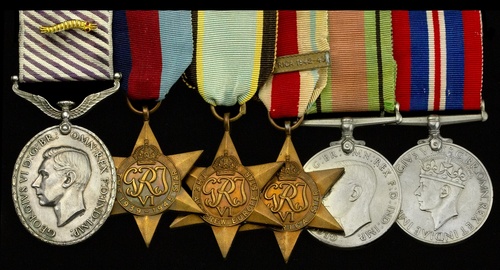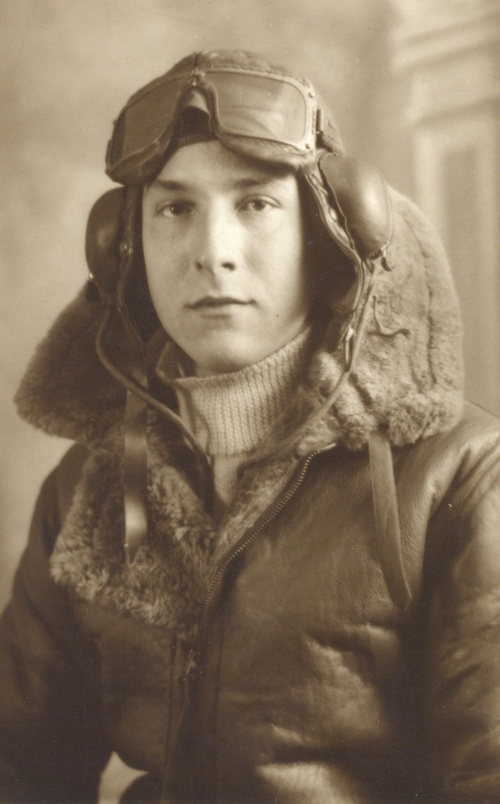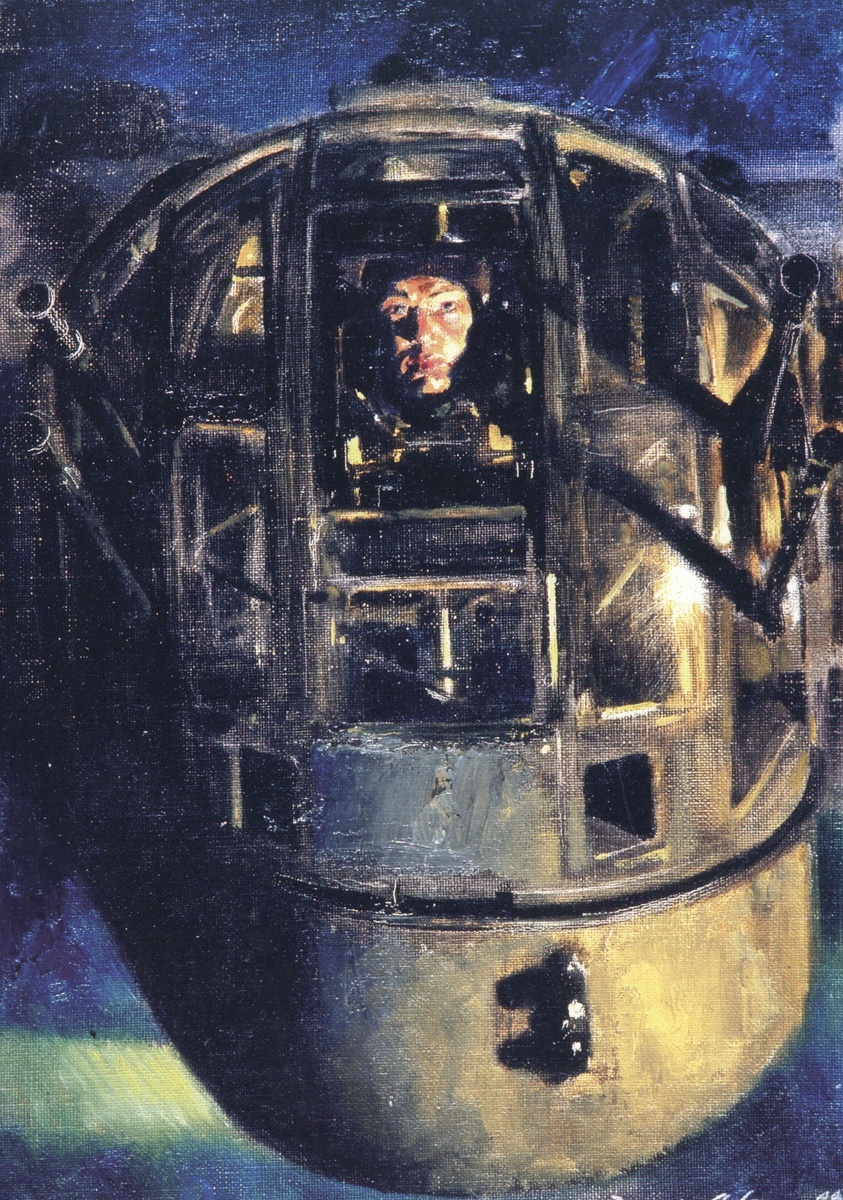Auction: 18003 - Orders, Decorations and Medals
Lot: 603
'A Sheffield air gunner, Flight Sergeant Frank Bell, recently awarded the D.F.M. for shooting down three enemy planes, seeks vengeance for the death of his only sister, Olive, who was killed in an air raid last December, every time he goes into action … He vowed to his father and mother that he would devote the rest of his time in the R.A.F. to avenging her death. That is his sole thought when he gets a German plane in his sights … '
A Sheffield newspaper report, refers.
An exceptional Second World War D.F.M. group of six awarded to Flight Lieutenant F. Bell, Royal Air Force, who swore to avenge the death of his sister in the Sheffield Blitz in December 1940
He didn't disappoint. As Rear Gunner of a Whitley of No. 58 Squadron - detailed to Bremen one night in February 1941 - he faced off four separate night fighter attacks, claiming two 'bandits' as destroyed, one probable and another as damaged
Distinguished Flying Medal, G.VI.R. (9417766 Sgt. F. Bell, R.A.F.); 1939-45 Star; Air Crew Europe Star; Africa Star, clasp, North Africa 1942-43; Defence and War Medals 1939-45, together with the recipient's Caterpillar Club membership badge, gold with 'ruby' eyes, the reverse officially engraved, 'Sgt. F. Bell', his embroidered and Air Gunner's brevet and set of related miniature dress medals, edge bruise to first, generally very fine or better (14)
D.F.M. London Gazette 22 August 1941. The original recommendation states:
'This Sergeant has done some really fine work since being in the Squadron. His exceptional enthusiasm and unfailing devotion to duty have been an example to all with whom he has come in contact.
On the 11th February [1941], on a trip to Bremen, his aircraft was attacked by a number of enemy aircraft. He succeeded in shooting down two of these and probably damaged a third. He has unfailingly shown great courage in face of the enemy and I unhesitatingly recommend that his fine operational record be recognised by the award of the Distinguished Flying Medal.'
Frank Bell was born on the 30 November 1919 in Sheffield on 30 November 1919, where he lived with his parents and only sister, Oilve, in Steade Road, Nether Edge. Having attended St. Barnabas School in Nether Edge, he left to become a junior traveller with local builders and contractors Dyson and Co. He matriculated at London University, and in his spare time was an active member of the Sheffield Tigers Rugby Club.
On the outbreak of hostilities in September 1939, Bell volunteered for aircrew duties in the R.A.F. and was selected to become a Wireless Operator/ Air Gunner. In the event, he became an Air Gunner, for he was deemed to be a 'Class A' gunner, 'above the average with credit', and gained a mark of 79% in the final exam. Air Gunners were originally selected 'for quickness of mental reaction, dependability in an emergency and a fighting spirit'. Bell was to surpass all of these qualities within a very short space of time.
No. 58 Squadron
Having attended an O.T.U. in the summer of 1940, he was posted to 'B' Flight of No. 58 Squadron at Linton-on-Ouse, Yorkshire, and he commenced his first operational tour in October, with a trip to the Skoda works at Pilsen in Czechoslovakia on the 20th. The Squadron was equipped with outdated Whitleys, capable of 250 m.p.h. and armed with only one machine-gun in its nose turret, and four Browning .303s in the rear powered turret, with a rate of fire of 80 rounds a second.
His trip to Pilsen having been aborted owing to problems with his gun, Bell and his crew were next assigned to bomb Stettin on the 23rd; this also proved a non-starter due to bad weather. Finally, on 14 November, his Whitley made it to Lorient, a seven and a half hour round trip. A spate of varied targets ensued over the next couple of months, from Turin in Italy to anti-shipping strikes on the docks at Duisberg and Emden; so, too, a strike against enemy ships in Brest harbour on 10 January 1941.
Bremen - 11 February 1941: two down, one probable and another damaged
It was on this date, as Rear Gunner in Whitley K4213 GE-K, that Bell nearly obtained ace-status in a single night. It was a remarkable feat. The above quoted newspaper report takes up the story:
'Bell was the rear gunner in one of our heavy bombers the night he won his award. It was his 13th trip over enemy country - he has done more than 40 since then.
He and his comrades were on their way to Bremen when they met with a series of attacks by German fighters.
The first came at them while they were still over the sea. It was a bright moonlight night and he could see the swastika markings plainly on the Messerschmitt. He opened fire at 150 yards range, gave him a long burst, and saw the headlights go out at once. 'Jerry' dived steeply into a cloud and that was the last they saw of him.
Number two came along just as they reached the Dutch coast. He shot over the British bomber and as he went astern, Bell gave him a burst. He wasn't seen again either.
Twenty minutes later, Bell's captain told him there was a third fighter approaching from the port beam, and this time the captain swung the bomber round to give him a chance to get him. 'Jerry' opened fire first with tracers, but Bell at once replied. That fighter was last seen with smoke and flame shooting out of him.
There was a fourth attack just as they got to Bremen. Three Messerschmitts came up in formation on the bomber's tail. Bell picked out the middle one of the three and gave him a terrific burst. There was a sudden burst of smoke and flame and as he fell the cloud glowed red.
All four fights happened within an hour and 40 minutes, but they did not prevent the bomber reaching Bremen, dropping its bombs on the target, and getting safely home. Bell was credited with three certain successes and a probable fourth, so his 13th trip was certainly unlucky for someone else.'
On returning to base the whole crew were forced to bale out over Fulbeck in Lincolnshire due to a lack of petrol. None were injured apart from Bell who suffered a twisted ankle on landing. He was duly enrolled in the membership of the Caterpillar Club.
Interestingly, the same newspaper source refers to the fact Bell had to bale out on another occasion, 'and once he and other members of crew spent three days and nights without water in a dinghy which was floating about in a minefield.'
Rest of first tour
Back on operations on 28 February 1941, Bell and his crew were assigned to attack the mighty Tirpitz at Wilhelmshaven; their aircraft was attacked by 109s. And he was later assigned on 4 May 1941 - to a similar attack against the Scharnhorst and Gneisenau, his flying log book log noting, 'Hits observed on ships'.
His targets otherwise comprised regular sorties against heavily-defended targets in Germany, including three trips to Cologne, two Berlin, two to Bremen and and two to Kiel. These in addition to a strikes on Duisburg and Dusseldorf.
Having completed a full tour with the Squadron In June 1941, Bell was sent on well-deserved leave, taking his dog 'Raaf' with him; a newspaper cutting, refers.
Second tour: 76 Squadron
Bell returned to an operational footing with No. 76 Squadron in April 1942. Based at Middleton St. George, the Squadron was equipped with Halifaxes.
In late May, Bell records flights as 2nd Pilot to Squadron Leader Iveson and Pilot Officer Dobson respectively, during air tests in Halifax's MP - D and K. But he otherwise flew as a Wireless Operator.
He was to make three further trips to Germany before being posted to the Middle East. These were the '1000 Bomber' raids on Cologne on 30 May and Essen on 1 June, Bell noting in his flying log book on the former occasion, 'Dantes inferno'. His final German trip was against the 'Big City' on 27 June.
On the 10 July 1942, Bell was the Wireless Operator in Halifax E 7672, piloted by Squadron Leader Iveson, on an eight and a half hour flight to Gibraltar, along with 15 other aircraft from the Squadron, who had been detached to start operations in the Middle East. On the 12 July they continued their journey onward in a 12-hour flight to Kasfareet in Egypt and, finally, to Agir in Palestine.
The Squadron subsequently operated from two advanced bases in Egypt at Shallufa and Landing Ground 224, situated on the Alexandria to Cairo road.
Formation of No. 462 (R.A.A.F) Squadron: Tobruk run
In early August 1942, No. 76 Squadron moved to Fayid and was joined by No. 10 Squadron to form No. 462 (R.A.A.F.) Squadron, with attacks continuing on Tobruk Harbour and A.A. gun emplacements. During this period Frank had also acquired another dog, which he again named 'Raaf', perhaps in honour the Squadron's Australian aircrew.
Bell took part in 15-night operations in this area in July-September 1942, each round trip lasting about seven hours; his log book entry for 5 September states, 'encountered heavy flak and fighters over the target'. He flew his final mission on the 15th, another attack on enemy shipping in Tobruk harbour. Enemy defences were described 'as twice as strong as of late', a fact not lost on Bell, who was acting as Wireless Operator to Squadron Leader Iveson in Halifax E7672: 'Operations - holed - crash-landed at base' (ibid). It was his 50th sortie.
By now a Flying Officer, he was seconded to instructional duties in South Africa.
Post-war
At the end of the war Bell departed the R.A.F. to work with his father in his drapery business in Sheffield but, finding civilian life dull, he re-joined the R.A.F. and was granted his old rank of Flying Officer.
In May 1951, Bell was sent to No. 5 Air Navigation School at Lindholme, to attend a refresher course as a Wireless Operator / Signaller. Here he flew in Anson aircraft, also developing his skills in map-reading and navigation, and occasionally acting as the second (safety) pilot. He was given his pilot's 'Wings' during this period.
Most of this time was taken up training with Rebecca and Eureka equipment, using Wellington aircraft. This system was invented in the later stages of the last war, wherby a portable ground-based beacon - Eureka - sent pulses of radio waves to aircraft that had been installed with airborne direction-finding equipment - Rebecca. Initially designed to assist with the air-drop delivery of supplies to Army/Resistance groups, it was later used as a blind homing and approach device for aircraft.
On the 12 August 1951, Bell found himself as a passenger in a York aircraft on a flight from Lyneham to R.A.F. Shaibah in Iraq, where he was posted as a Navigator in Valetta aircraft. In late November, he was again posted, this time to R.A.F. Mauripur in Pakistan. This base was shared with the newly formed Pakistan Air Force and was known as No. 48 Staging Post, mainly for troops involved in the Korean War.
Having then returned home in the summer of 1953, Bell successfully completed a Signaller's Course and was promoted to Flight Lieutenant. He subsequently undertook tours of duty at the School of Maritime Reconnaissance at St. Mawgan was posted as a Signaller to No. 240 Squadron, based at Ballykelly, Ireland, and flying Shackletons, in July 1954. The Squadron participated in maritime exercises over the Atlantic during the Cold War years.
Between September 1956 and March 1960, Bell served at the Royal Aircraft Establishment at Farnborough, where he undertook duties with the Radio Flight within the Experimental Flying Department. He flew in a number of different types of aircraft, including Canberra, Meteor and Javelin jets.
In May 1960, he attended a course at the Maritime Operational Training Unit at Kinloss, again flying Shackleton aircraft and was afterwards posted to No. 205 Squadron at Changi, Singapore. The Squadron flew Shackleton aircraft and maintained maritime recce facilities in the Far East, as well as maintaining 'search and rescue' operations. Having latterly acted as the unit's Signals Leader, Bell came home and was placed on the Retired List in November 1963; he had flown over 3000 hours in 38 different types of aircraft.
He died in May 1977.
Sold with the recipient's original R.A.F. Flying Log Books, privately bound as one volume, covering the periods July 1940 to August 1944, and thence to his second career, from May 1951 to November 1963; a slightly confused period of entries in April-May 1942, with one page cut out; together with R.A.F. Observer's and Air Gunner's Flying Log Book (Form 1767 type), with opening statement, 'Supplementary Log Book from June 1942', which covers the aforementioned period of confusion, and beyond.
Also sold with several wartime photographs, including portrait images, and a pair of presentation pewter tankards, one inscribed to the recipient from No. 205 Squadron, Changi, October 1963 and the other from Changi R.F.C., 1963.
Subject to 20% VAT on Buyer’s Premium. For more information please view Terms and Conditions for Buyers.
Sold for
£2,700









